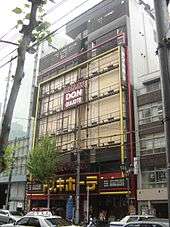Don Quijote (store)
|
| |
| Public (TYO: 7532) | |
| Industry | Retail |
| Founded | September 5, 1980 (Tokyo, Japan) |
| Headquarters | Meguro, Tokyo |
Number of locations | 163 stores (February 2011) |
Area served | Japan, Hawaii |
| Products | Clothing, food, jewelry, housewares, tools, sporting goods and electronics. |
| Revenue |
|
|
| |
|
| |
| Total assets |
|
| Total equity |
|
Number of employees | 4,391 |
| Website |
donki |
Don Quijote (ドン・キホーテ) is a discount chain store that has over 160 locations throughout Japan as well as three stores in Hawaii.[2] It carries a wide range of products, from basic groceries to electronics to clothing. The store is well known in Japan and is often referred to by its shortened name Donki (ドンキ). Distinctly, Don Quijote tends to keep very late hours for Japanese retailing (to 3 or 5am, or even 24 hours) and it packs its goods from ceiling to floor in a distinct merchandising strategy.
History

Don Quijote opened its first store in Suginami, Tokyo in September 1980 under its original name, Just Co. Originally a retail store, Just Co. quickly switched to wholesale in 1982.
The company opened its first "Don Quijote" named store in Fuchu, Tokyo in March 1989. With the name change, the store also changed its primary business from wholesale to retail. It was not until 1995, six years later, that Just Co. followed suit and it changed its corporate to Don Quijote Co., Ltd as well. In June 1998, the company was listed on the Tokyo Stock Exchange.[2]
As one of the few discount stores in Japan, the end of the Japanese economic bubble did not have disastrous effects for Don Quijote. Instead, the sudden economic uncertainty caused the Japanese public to become more thrifty and therefore helped to boost sales at its stores during the early 1990s.
In 2005, idol group AKB48 opened its theater on the eighth floor of the Don Quijote Akihabara Outlet in Tokyo.[3]
In 2013, Don Quijote purchased Marukai Corporation U.S.A. including stores in Hawaii and California.[4]
Theme song
Don Quijote is known for the distinctive song that plays in its stores. The song is called "Miracle Shopping" (ミラクルショッピング) sung by Maimi Tanaka (田中マイミ), a Don Quijote store employee.[5] "Miracle Shopping" was released as a maxi single in 1999.[6]
Controversy

Arson
In December 2004, four stores in the Kantō area were damaged or destroyed by arson attacks. Three store employees, Morio Oshima, 39, Mai Koishi, 20, and Maiko Sekiguchi, 19, died in the first arson incident. In 2007, Noriko Watanabe, 49, was found guilty of setting the fires and sentenced to life imprisonment. Don Quijote received harsh criticism at the time for poor store layout that made it difficult to find exits.[7]
Roller coaster
Coordinates: 35°39′44.73″N 139°44′5.11″E / 35.6624250°N 139.7347528°E
In 2005, Don Quijote began building a "half-pipe" roller coaster on the roof of its eight story Roppongi store. Roppongi is a heavily populated area in the core of Tokyo, and many residents and businesses were upset with the idea of having a roller coaster in their neighborhood because of the spectacle, noise and crowds it will likely create. The project was completed in 2006 but due to increasing pressure from concerned groups in the area it has never been operated. As of 2016, the structure still exists. Don Quijote has not announced what future plans they have for it. [8]
Overseas Assets
Don Quijote purchased the Marukai Japanese chain stores in USA in 2013, splitting it into Marukai and Tokyo Central Markets chains.[9]
References
- 1 2 3 4 5 "Shared Research report - Don Quijote".
- 1 2 "Corporate History". Retrieved 2008-03-19.
- ↑ "Girl idol group about mass exposure, fans". The Japan Times Inc. The Japan Times. August 24, 2010. Retrieved June 29, 2011.
- ↑ All 11 Marukai Stores to Be Sold – Rafu Shimpo. Rafu.com (2013-09-04). Retrieved on 2014-05-24.
- ↑ ドンキ・ホーテのテーマ♪ミラクルショッピング (Don Quijote's Theme: Miracle Shopping)
- ↑ Maimi Tanaka on Oricon
- ↑ "Don Quijote store arsonist gets life for three deaths". The Japan Times. 2007-03-24. Retrieved 2008-03-19.
- ↑ http://allabout.co.jp/gm/gc/80080/
- ↑ http://www.rafu.com/2013/09/all-11-marukai-stores-to-be-sold/
External links
| Wikimedia Commons has media related to Don Quijote (store). |
- Official website (Japanese)
- Official website